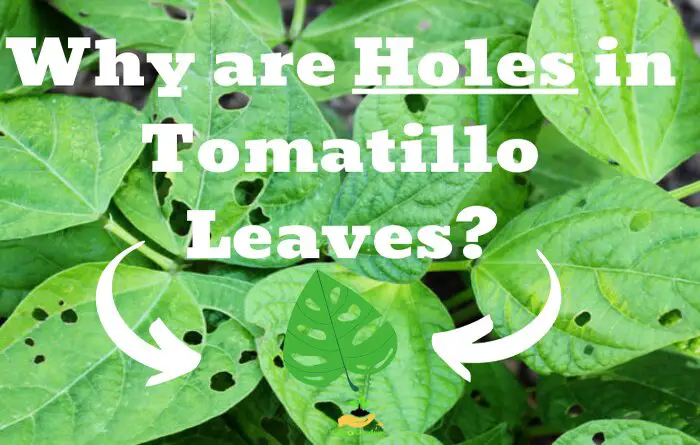Why are Holes in Tomatillo Leaves? [3 Reasons & How To Fix]
Farmers sometimes get scared when they see holes in their tomatillo leaves. Figuring out what caused the holes takes some times, but in this article we will show exactly what causes this issue.
Holes in tomatillo leaves are caused by several different insects. The most common cause of holes in tomatillo leaves is the cabbage looper. Other insects and pests such as caterpillars, flee beetles and slugs are also causing holes in the tomatillo leaves.
| What Cause Holes in Tomatillo Leaves |
|---|
| 1. Caterpillars |
| 2. Flea beetles |
| 3. Slugs |
1. Caterpillars
Chewed holes in tomatillo leaves indicate the presence of caterpillars. Caterpillars are characterized by having chewing mouthparts. The developed larva reaches 30-40 mm, with a greenish-brown head with black spots and stigmas (breathing holes) .
It has several clear longitudinal lines and a thick yellowish stripe that runs through its entire body . The color is very variable, from green to dark almost black , passing through pinkish or yellowish.
They feed on stems, leaves, shoots, fruits and seeds. Its damage appears as cuts and perforations in the leaves. Caterpillars usually hide on the underside of leaves and can be detected by the presence of droppings.
For prevention purposes, you can spray tomatillos leaves once a week with garlic infusion or to remove the weeds. After harvesting tomatillos damaged by caterpillars, all the bushes should be pulled out and burned. Dig up the earth in the garden or in the greenhouse.
To eliminate caterpillars, you have to fumigate with: Bacillus thuringiensis(Bt). It is a biological insecticide treatment (it is a bacterium) that eliminates caterpillar larvae.
It is an ecological product, perfect for organic farms or gardens, and is not harmful to beneficial insects or animals, nor is it toxic to humans.
Or try picking them by hand, dropping the caterpillars into a bucket of soapy water.
Cabbage looper
The most common cause of holes in tomatillo leaves is the cabbage looper. Cabbage loopers attack tomatillo plants, so this is usually the first pest to show up in your garden.
Cabbage loopers are small, green caterpillars with a brown stripe along their backs. They feed on the leaves of tomatillo plants, leaving behind holes and chewed leaves.
To prevent cabbage lopper infestation, you can cover your tomatillo plants with row covers or plant tomatillos in containers so that they are not exposed to cabbage looper eggs during their winter cycle.
Companion planting is a useful deterrent to many pests. Cabbage loopers are repelled by herbs and flowers such as chamomile, dill, lavender, eucalyptus, marigolds and thyme, so it would be a good idea to plant them near tomatillos.
The easiest way to remove cabbage loopers is to pick them off the leaves and throw them away. If you have a lot of damage, you can spray your tomatillo plants with neem oil, which will kill any eggs that are laid on the leaves.
Look for the small green caterpillars on the underside of your tomatillo leaves, and pick them off one at a time in the mornings or when temperatures are cool. If you find more than one, this means there are more cabbage loopers in your garden and will need to be removed.
If prevention is not effective and the caterpillar manages to infest the tomatillo leaves, a specific Bacillus thuringiensis (Bt) based product must be used. When cabbage loppers ingest the bacteria, they stop feeding, become paralyzed and quickly die.
When they die, the caterpillars release new generations of bacteria ready to attack other caterpillars. It is important to use the bacteria at the first sign of an infestation.
Tomato hornworms
The other common caterpillar that causes holes in tomatillo is the hornworm, but they are not as common as cabbage loopers. This tomato caterpillar feeds on a wide variety of popular of plants, including tomatillos.
A moth called tomato hornworm (Manduca quinquemaculata) lays its eggs on the leaves of tomatillos, tomatoes, peppers and other nightshade vegetables. Tomato hornworm eggs hatch from the leaves in five days, and the larvae begin their life cycle above ground. The larvae then feed on these plants, leaving holes in the leaves.
Tomato hornworms are large green caterpillars with black stripes along their backs. They feed on the leaves of tomatillo plants, leaving behind holes and chewed leaves.
Signs of a tomato hornworm caterpillar garden infestation include black caterpillar droppings on the soil around nightshade leaves.
They are a larger caterpillar and are easily identified on the vine. Hand picking and placing in a bucket of water is an effective way on how to kill tomato hornworms.
Buy an insecticide that contains Bacillus Thuringiensis, a substance that is used to kill small hornworms.
Follow the instructions on the label of your insecticide and apply it on tomatillo leaves, including the inner part of the leaves.
Use it every 10 or 15 days until you have eliminated hornworms. Please note that it takes 1-2 days for Bacillus Thuringiensis to kill the worm.
2. Flea beetles
The flea beetle is a small, domed, shiny beetle, often black or metallic brown which jumps from plant to plant, eating the tomatillo leaves and making tiny holes in them.
They measure only about 2 to 5 mm in length and have two long antennae and two hard horny wings. Their hind legs are highly developed , which enables them to jump high and has earned them the nickname “earth fleas”.
Usually they are recognized by their damage: leaves, especially younger ones, that are riddled with dozens of small depressions and round holes.
Depending on the species, flea beetles attack cruciferous plants (cabbage, turnip), solanaceae plants (tomatillos, tomatoes, eggplants, potatoes) or vines . The leaves of these plants appear full of small holes, quite circular in shape. Most often, they nibble on young leaves, which are softer to their liking.
However, if there is too much on your plants, it can cause serious damage. Don’t ignore them. A ragged area can be caused by small holes, pitting, or irregular holes in the leaves. Flea beetles can also affect roots and fruits.
Small eggs are laid by flea beetles in weeds and plant debris, or in the soil around tomatillos. The tiny, pale white larval stage, which is a small and solitary one, begins above or below ground after the eggs hatch.
The larval stage pupates in the soil after a few months. As adults, their large jumping legs allow them to move plants wherever they please.
Like most insects, flea beetles are easier to prevent than to cure.
For example, transplant vegetables rather than sow them (young seedlings suffer more than more mature plants) or sow trap plants (radish, mustard) which will bear the brunt of the attack.
Probably one of the most effective techniques to combat flee beetles is to install an anti-insect veil on tomatillos. It will also allow you to fight against other pests that would have the bad idea to go through your garden.
Mulch on the ground will help keep the soil wetter, a condition that flea beetles dislike. You can try spraying the plants with neem oil or a natural pyrethrum product. Yellow or white sticky traps can also help.
Garlic or pepper decoctions would have a repulsive effect on flea beetles. Feel free to spray a little all over the plant, it’s worth a try.
3. Slugs
Slugs are mollusks that reach 4-5 centimeters long. They are very voracious and feed on a wide variety of vegetables leaves including tomatillos. You will see irregularly shaped holes usually starting from the edges of the leaves.
Slugs and snails have scraping mouthparts. Their presence is detected by the bright trail called mucus that they leave on the leaves after moving. They attack mainly at night, at dawn, on cloudy days, after rain or irrigation when the ground is wet and the atmosphere is moist.
To prevent them, it is recommended to create barriers around tomatillos with ash, sand or crushed eggshells. Beer traps can also be used or manually removed.
These rapidly multiplying and very active pests usually do not care whether they gnaw on seedlings or adult plants, although, of course, they prefer the tender pulp of young sprouts.
If you are a supporter of exclusively ecological methods, look for biological products that are safe for nature based on parasitic nematodes.
Slugs are afraid of parasitic nematodes. They can be purchase as a biological supplement, which consists of living microorganisms. The nematode does not harm tomatillos and the human body, so it can be used without fear.
Microorganisms are diluted in water (1 tablespoon per 10 liters) and watered around the tomatillos. The slugs will be gone in a week.
How to Prevent Holes in Tomatillo Leaves
Preventive measures that will help reduce the holes in tomatillo leaves:
- Don’t grow the same crops in the same place year after year. Crop rotation helps keep all pests off guard;
- in March-April, the soil beds are watered with boiling water;
- Spray your garden with a natural mixture of water, cayenne pepper powder, insecticidal soap and garlic to prevent sphinx moths from laying eggs on your tomatillos;
- Regularly weed weeds;
- Cover the ground around your plants in the nightshade family with a sheet of black plastic mulch;
- Lure hornworms with a trap crop. Planting a crop of dill can help keep hornworms away from your hemlock crops;
- Plants should not be planted close to each other. There should be a distance of 70 cm between seedlings;
- Thickened beds interfere with free air circulation, which leads to the development of diseases, and when pests appear, there is a high chance of losing absolutely the entire crop;
- It is necessary to check the leaves regularly – this simple measure will allow timely detection of insects and diseases. Pay attention to the bottom leaves;
- A good measure against pests is the introduction of insecticide granules into the soil;
- It is not necessary to use special preparations in the fight against insects. Moths can be caught with baits, and caterpillars can simply be shaken off the bush.




